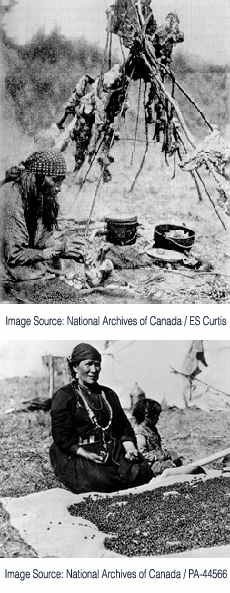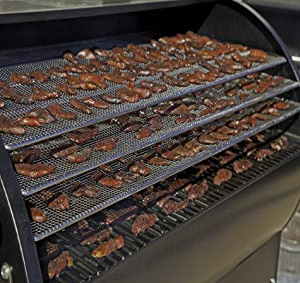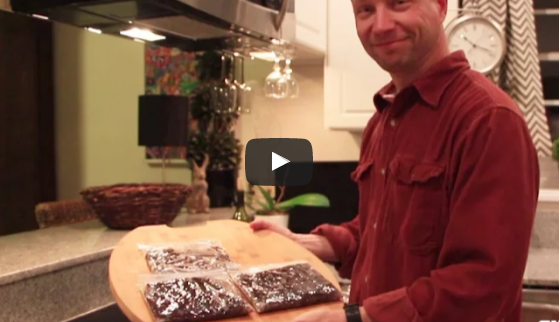
Beef jerky is an incredibly popular snack food, and while it may be high in sodium, it’s lean and full of protein. Things you might not know about this popular snack.
Beef jerky is thought to have originated in South America during the 1800s. The Quechua tribe, who were ancestors of the ancient Inca empire, produced a meat similar to beef jerky called ch’arki, or charqui. It was made by adding salt to strips of muscle tissue from game animals such as deer, buffalo, and elk, and allowing them to dry in the sun or over fires for extended periods of time. This method of preparation enabled the people to preserve meats during times when it was readily available and eat it when food was scarce. When the Spanish encountered this method of meat preservation, they adopted it and made it available to the rest of the world. It became a staple foodstuff for American cowboys and pioneers. Early explorers built smoke huts and hung cuts of meat over a fire to smoke cure the meat. True jerky was made when the meat was first flavored and then cured. Over the years, people discovered that the meat could be made more palatable by the addition of various spices.
Click Here to see Things You Didn’t Know About Beef Jerky
Jerky, by definition, is lean meat that’s been trimmed of fat, cut into strips, and dried with salt. Both the drying and salting processes prevent spoilage and bacterial growth, and when prepared properly, it can last for months on end.
We think beef jerky is one of the greatest snacks of all time. High in protein, easily portable, shelf-stable, and downright delicious, it appeals to a variety of people for a variety of reasons. In fact, we are living in a bit of a jerky renaissance. Even with growing popularity, there’s a lot of things you may not know about this amazing snack.
Today, some less expensive brands of beef jerky are made by finely grinding the meat, mixing it with spices and seasonings, and pressing the resulting paste into strips before drying. Thankfully, there are still plenty of companies — as well as artisanal producers — who make jerky the old-fashioned way, using whole muscle meat dried over low heat. Some producers smoke the meat to preserve, dry, and flavor it simultaneously.
The meat and a curing solution are all the components needed for making meat jerky. The primary starting material for making jerky is the meat. For the best tasting jerky, the beef used is range fed, 100% premium, visually lean, United States Department of Agriculture (USDA) inspected, flank steak. There are some manufacturers who produce a slightly different textured beef jerky using ground beef. In most cases, it requires over five pounds of meat to produce one pound of jerky. While most meat jerky is made using beef, various other types of meat are also used. Turkey has become popular because it is perceived as a healthier alternative to beef. It produces a jerky that is not as tough as beef jerky. Pork is another meat that is made into jerky. This jerky has a slightly different taste.
The curing solution is used to provide a better taste and a longer shelf life for the beef jerky. It is also responsible for the final color of the product. The cure solution also has an antimicrobial effect, which prevents the growth of harmful bacteria. A typical curing solution is composed of water and salt plus sodium nitrite. The salt has a dehydrating effect on the meat. The sodium nitrite helps to retard the development of rancidity and stabilizes the color. Sodium ascorbate may also be added to increase the pink color of the meat.
The curing solution is mixed with a brine, which is an aqueous solution of seasonings, spices, salt, sugars, and phosphates. Some common flavorants used include soy sauce, lemon juice, pepper, monosodium glutinate (MSG), or garlic powder. Worcestershire sauce is also used, as is teriyaki sauce. The sugars that are used to provide a level of sweetness include sucrose, dextrose, brown sugar, and dark corn syrup. Flavored salts such as hickory salt or onion salt are also included in the brine. Sodium phosphates may also be used. Some manufacturers use a material known as liquid smoke, which is made by dissolving smoke in water. This material gives the meat a smoke cooked taste without requiring smoke during cooking. Since jerky is very tough, a tenderizing agents such as polyphosphates or papin enzyme can be included. The use of these materials is limited however, because it increases the amount of time required for drying.
Did you know…

Jerky has been around for a VERY long time.
The word “jerky” can be traced back to the ancient Quechuan word “ch’arki.”
Native Americans brought along jerky on long journeys for a protein-rich food.
Check out our History of Beef Jerky to learn more about jerky’s rich and storied tradition.
Beef Jerky is an EXCELLENT source of protein.
Beef jerky was used in the military after World War I as a source of protein for soldiers.
Women’s Health ranks beef jerky as 1 of 7 High Protein Snacks that “can help you lose weight.”
Our Old Fashioned Original has 40g of protein per 2.5 ounce bag (16g of Protein Per 1 Ounce Serving).
Beef Jerky shrinks in size up to 3-1.
The process of dehydration can reduce the weight anywhere between 1/2 to 2/3 of the original weight. For example, 3 pounds of raw meat can shrink down to 1 pound.
The yield (going from bigger – smaller) is one of the reasons jerky can be so expensive, but also so nutritionally dense.
Beef Jerky is a well-traveled snack.
NASA has been sending astronauts into space with beef jerky since 1996.
Jerky and dried meats are a global culinary phenomenon.
Jerky exists in one form or another all over the world. In South Africa, biltong is cured with the help of vinegar, salty-sweet bakkwa is popular in China, carne seca is eaten in Mexico, dendeng is dried via frying and is beloved in Indonesia, and jerky is called sukuti in Nepal.
Read on for things you may not have known about beef jerky.
Beef Jerky is big business.
The dried meat snack category (which includes beef jerky) is a $2.5 billion industry in the United States and continues to grow!

Initial meat preparation
1 Jerky can be prepared from either whole muscle or ground beef. In both cases, the meat is first treated to remove the bones and connective tissue, then the fat is removed. There are generally three methods for defatting the meat. In one instance, the meat is put into a large centrifuge. This device creates a spinning motion, which causes the liquid fat particles to separate from the meat. In another method, the meat is pressed to squeeze out all of the fat. Fat can also be removed from the meat by filtering it.
In addition to deboning and defatting, the meat is subjected to other processes, which help remove foreign bodies and other unwanted materials. The meat is put on a conveyor and workers inspect it as it passes by. It may then be put on a metal screen and shaken to remove unwanted material. Other processes may include water separation and the removal of any metals via magnets. Some plants even use x-ray examination to ensure the purity of the meat prior to use.
Preparing the curing solution
2 While the meat is being processed, the curing solution may be prepared. This is typically done in a large tank equipped with mixing blades. Water is filled into the tank and the salt, seasonings, and other materials are mixed in. The solution is heated as required until it is ready to be used. Since some of the materials are not water soluble, it is often necessary to mix before use.
Meat processing and curing
3 At this point, the meat can either be frozen and cut up into chunks by an automatic cutting machine or it can be ground up using a bowl chopping machine. Using the frozen meat method, the meat is allowed to partially thaw, which causes a release of the natural juices. The meat can then be dipped in the curing solution. It must be left in for an appropriately long time to allow total penetration of the liquid, however, not so long as to risk meat contamination. Another method of curing the meat is by injecting it with the curing solution by means of a multi-needle device. Meat treated as such is then sent to a large, stainless steel tumbling device that contains additional curing solution. This helps tenderize the meat and ensures the total penetration of the solution. If ground meat is used, the curing solution can be mixed directly into the meat to produce a workable paste. While ground meat is easier Once the meat is defatted, it is mixed with the curing solution.
Once the meat is defatted, it is mixed with the curing solution. To work with, it produces a jerky with somewhat undesirable characteristics.
4 After seasoning, the meat is molded into blocks and cooled to a temperature of 18-28° F (-8 – -2.2° C). When it is adequately frozen, it is sliced into strips. The strips are preferably cut in line with the fiber of the meat. This makes the final product have a more natural looking texture. These strips are then spread out onto wire mesh trays and sent to drying ovens to be cooked. Here the meat strips are heated to 160° F (71.1° C) and gradually cooled to about 90° F (32.2° C). Depending on the method by which the meat was initially prepared, cooking can take as long as 12 hours. During cooking, the moisture in the meat is reduced to 20-40%.
Packaging
5 Many different types of packaging are used for beef jerky. To preserve freshness, most jerky is packaged in a vacuum-sealed bag. One manufacturer uses a triple barrier bag in which the meat is put in, the package is evacuated, filled with nitrogen, and sealed. This method removes all oxygen from the system thereby preventing spoilage due to oxidation. Recently, manufacturers have introduced a resealable type package. These bags are initially vacuum sealed, but also have a zip lock so they can be closed after opening.
Become An Expert At Food Storage
Early Native Americans (and even people who lived in the middle ages and other tribal cultures) were experts at preserving food — because this is all they knew. They can survive by living off the land and it’s not a big deal. It’s like us going to the grocery store. We’re experts at buying groceries.Survival for many is not going to be as easy as it was for early Native Americans. For many it’s going to be incredibly hard work, and for quite a few impossible.
Now, we can learn survival methods, we can go out and practice them, but the whole game changes when suddenly we have to live 100% on our own and off the land, providing food for ourselves and for our families — putting these survival skills we’ve been reading about into practice in actual real life and death situations.
I’ve got a feeling a lot of people don’t realize just how tough it’s going to be.
We are going to need each other. We won’t be able to do this alone.
Books can be your best pre-collapse investment.
Carnivore’s Bible (is a wellknown meat processor providing custom meat processing services locally andacross the state of Montana and more. Whether your needs are for domestic meator wild game meat processing)
The Lost Book of Remedies PDF ( contains a series of medicinal andherbal recipes to make home made remedies from medicinal plants and herbs.Chromic diseases and maladies can be overcome by taking the remediesoutlined in this book. The writer claims that his grandfather was taughtherbalism and healing whilst in active service during world war twoand that he has treated many soldiers with his home made cures. )
Easy Cellar(Info about building and managing your root cellar, plus printable plans. The book on building and using root cellars – The Complete Root Cellar Book.)
The Lost Ways (Learn the long forgotten secrets that helped our forefathers survive famines,wars,economic crisis and anything else life threw at them)
LOST WAYS 2 ( Wordof the day: Prepare! And do it the old fashion way, like our fore-fathers did it and succeed longbefore us,because what lies ahead of us will require all the help we can get. Watch this video and learn the 3 skills that ensured our ancestors survival in hard times offamine and war.)
Survival MD (Best Post Collapse First Aid Survival Guide Ever)
Conquering the coming collapse (Financial advice and preparedness )
Liberty Generator (Build and make your own energy source)
Backyard Liberty (Easy and cheap DIY Aquaponic system to grow your organic and living food bank)
Bullet Proof Home (A Prepper’s Guide in Safeguarding a Home )
Family Self Defense (Best Self Defense Strategies For You And Your Family)
Survive Any Crisis (Best Items To Hoard For A Long Term Crisis)
Survive The End Days(Biggest Cover Up Of Our President)
Drought USA(Discover The Amazing Device That Turns Air Into Water)


